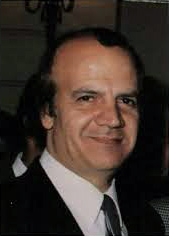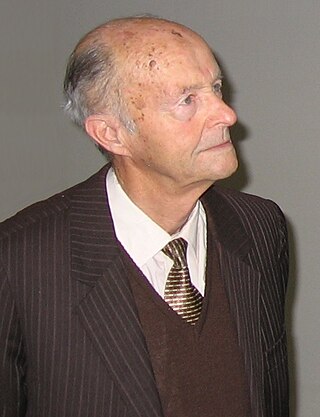Related Research Articles

University College, informally known as Castle, is a college of Durham University in Durham, England. Centred on Durham Castle on Palace Green, it was founded in 1832 and is the oldest of Durham's colleges. As a constituent college of Durham University, it is listed as a higher education institution under section 216 of the Education Reform Act 1988. Almost all academic activities, such as research and tutoring, occur at a university level.
Sedimentology encompasses the study of modern sediments such as sand, silt, and clay, and the processes that result in their formation, transport, deposition and diagenesis. Sedimentologists apply their understanding of modern processes to interpret geologic history through observations of sedimentary rocks and sedimentary structures.
Kenneth Jinghwa Hsu Ph.D., M.A., born 28 June 1929, is a Chinese scientist, geologist, paleoclimatologist, oceanographer, government advisor, author, inventor and entrepreneur who was born in Nanjing, China.

Carbonate rocks are a class of sedimentary rocks composed primarily of carbonate minerals. The two major types are limestone, which is composed of calcite or aragonite (different crystal forms of CaCO3), and dolomite rock (also known as dolostone), which is composed of mineral dolomite (CaMg(CO3)2). They are usually classified based on texture and grain size. Importantly, carbonate rocks can exist as metamorphic and igneous rocks, too. When recrystallized carbonate rocks are metamorphosed, marble is created. Rare igneous carbonate rocks even exist as intrusive carbonatites and, even rarer, there exists volcanic carbonate lava.

Dr. Wissam S. al-Hashimi was an Iraqi geologist born in Baghdad. He was Secretary General of the Union of Arab Geologists until his death in 2005. In 2001 he was elected president of the Geological Society of Iraq and was president of the Union of Arab Geologists. From 1996 to 2002 he was vice president of the International Union of Geological Sciences (IUGS). He was killed in late August or early September 2005.

In geology, a bed is a layer of sediment, sedimentary rock, or volcanic rock "bounded above and below by more or less well-defined bedding surfaces". Specifically in sedimentology, a bed can be defined in one of two major ways. First, Campbell and Reineck and Singh use the term bed to refer to a thickness-independent layer comprising a coherent layer of sedimentary rock, sediment, or pyroclastic material bounded above and below by surfaces known as bedding planes. By this definition of bed, laminae are small beds that constitute the smallest (visible) layers of a hierarchical succession and often, but not always, internally comprise a bed.
Gerard Viner Middleton FRSC, often known as Gerry Middleton, was a Canadian geologist and university teacher.
Eric Walter Mountjoy was a Canadian geologist, who spent much of his career as a professor at McGill University. He was a foremost expert on sedimentology, Devonian reefs, carbonate diagenesis, porosity development and the structure of the Rocky Mountains. His research has provided useful applications to the petroleum industry.
Paul Goldberg is a geologist specializing in geomorphology and geoarchaeology who had done extensive worldwide field researches.

John P. Grotzinger is the Fletcher Jones Professor of Geology at California Institute of Technology and chair of the Division of Geological and Planetary Sciences. His works primarily focus on chemical and physical interactions between life and the environment. In addition to biogeological studies done on Earth, Grotzinger is also active in research into the geology of Mars and has made contributions to NASA's Mars Exploration Program.

Milan Mišík was Slovak geologist and university professor. He excelled particularly as an expert in microfacies analysis, stratigraphy, sedimentology, petrography of sedimentary rocks, but also in paleogeography, general and structural geology and tectonics. His best known scientific works were dealing with carbonate rocks and exotic conglomerates.
John Robert Lawrence Allen, was a British geologist who made substantial contributions to sedimentology and archeology. He took a 1st class degree in geology at the University of Sheffield in 1955 and then proceeded to research for a PhD. However, notwithstanding declining to submit his thesis for examination, his outstanding qualities were recognised by the Professor of Geology at Reading University, another, but unrelated Percival Allen, with the award of the Martin Lees Research Fellowship in 1958. So began a career at the University of Reading which continued to his retirement: appointment as lecturer in geology in 1961 was followed by promotion to Reader in 1967 and to a Personal Professorship of Geology in 1972 at the age of 39. In 1988 he was appointed Director of the newly formed Postgraduate Research Institute in Sedimentology. The flagship MSc trained many outstanding students, among whom are leading figures of the world's oil industry. Emeritus Professor since 2001, John continued to teach and be involved in the university until his death.

Lawrence Alexander Hardie was an American geologist, sedimentologist, and geochemist.
Isabel Patricia Montañez is a paleoclimatologist specializing in geochemical records of ancient climate change. She is a distinguished professor and a Chancellor's Leadership Professor in the department of earth and planetary sciences at University of California, Davis. As of 2021, Montañez is the director of the UC Davis Institute of the Environment.

Gail Ashley, née Mowry, is an American sedimentologist. She is known for her studies of the Olduvai Gorge sediments, focused on the water supplies available to hominids and the paleoclimate of the region. She has participated in multi-disciplinary projects that include meteorology, oceanography, paleoanthropology, and archaeology. She has served in professional organizations in the fields of sedimentology and geology, including the presidency of the Geological Society of America, the second woman to hold that post.
Alfred George Fischer was a German-American geologist.

Lindsay Boyd Collins was an Australian marine geologist and sedimentologist, a faculty member in the department of applied geology at Curtin University in Western Australia. He was interested in studying the continental shelf of Western Australia and coral reefs. Collins was a prominent scholar, he has completed projects on continental shelf mapping of Australian shelves, microbialites and seagrass banks at Shark Bay, and coral reef studies at the Abrolhos, Ningaloo, Scott Reef, the Rowley Shoals and the Kimberley.
Sampat Kumar Tandon is an Indian geologist and a professor emeritus of geology at the University of Delhi. He is a former pro-vice chancellor of Delhi University, Sir J. C. Bose Chair Professor of the department of Earth and Environmental Sciences at the Indian Institute of Science Education and Research, Bhopal and a D. N. Wadia Chair Professor of the department of Earth Sciences at the Indian Institute of Technology, Kanpur.

Pamela Hallock Muller is a scientist, oceanographer and professor at the University of South Florida in the College of Marine Science.

Silvia Frisia is a professor of Earth Science at the University of Newcastle, Australia. Frisia's work on carbonate crystals as archives of Earth's past environments and climates is recognised internationally. Her recent work has focussed on the role of Antarctic volcanism on the Southern Ocean.
References
- ↑ "University College MCR Maurice E. Tucker Room". University College Middle Common Room. Archived from the original on 28 June 2011. Retrieved 7 September 2011.